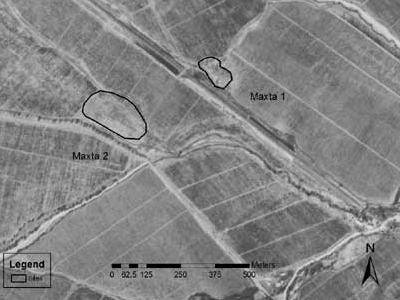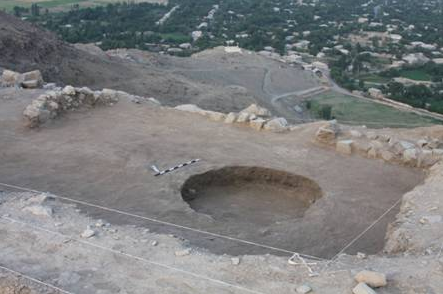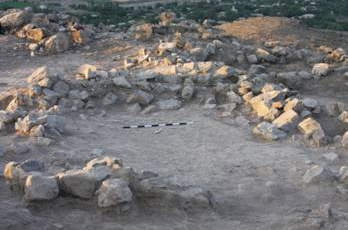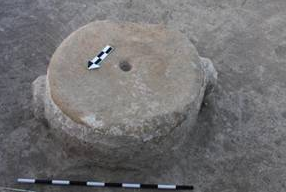Oğlanqala is located atop a 140m high hill (Karatepe, black mountain) which lies near the northern edge of the Sharur Plain, the largest fertile area in Naxçıvan, adjacent to the Arpaçay river. The site lies just south of one of the major passes through the Zangezur mountains (Figure 1). Oğlanqala is thus in a position to control one of the major north-south passes through the Lesser Caucasus, between Lake Urmia and Lake Sevan, as well as one of the largest fertile plains in the southern Caucasus. The main fortification walls at Oğlanqala enclose an area of about 10 hectares, although extramural occupation on the mountain covers an additional 2-5 hectares.
Architectural Survey
In 2008, we focused on mapping and surveying this complex site. Robert Bryant (GSU) used a total station to produce a topographic map of the mountain and to map all of the standing architecture (Figure 2). He also recorded some off-site features, including an Early Iron Age burial mound located immediately northwest of the site. The architecture on the site dates to a number of different periods. In many cases we were able to identify distinctive architectural features to specific periods, based on evidence from excavation. Middle Iron Age fortification walls, late Iron Age house walls and Medieval rubble architecture were all recorded by total station and incorporated into a GIS. By comparing the standing architecture to the Quickbird imagery of this area, we were able to fill in some of the gaps in the fortification walls.
Surface Collection
In addition to this map, Lauren Ristvet undertook a systematic sherd collection of this site. The site was divided up into 22 different major collection units based on standing architecture and topography (Figure 3). Many of these units were further subdivided, particularly if they included dense ancient architectural remains. Five periods were recognized in the course of survey—Late Bronze Age, Early Iron Age, Middle Iron Age, Late Iron Age and Medieval. By mapping where we found pottery from different periods, we were able to see how the size and use of the site had changed over time.
We found only a couple of painted sherds at Oğlanqala that may belong to the Late Bronze Age. This limited material could suggest that the site was first occupied at the end of the second millennium BC. Similarly, we encountered very little Early Iron Age pottery on the site itself. Gray groovy ware sherds were present on a burial mound northwest of the site; and a few similar sherds were found on top of the citadel (Figure 4). It is possible that the citadel was originally built during this period, but there is no evidence to support this hypothesis yet from the excavated areas.
Middle Iron Age pottery, in contrast, was much more common—occurring in nearly every collection unit on the entire site. Most of the larger fortification walls—and the initial construction of the citadel probably dates to this period (Figure 5).
Late Iron Age pottery was similarly very common across the entire site; it is possible that the extensive areas of private houses recognized in the south and southwest all date to this period, given the almost complete lack of earlier material in this area (Figure 6).
Finally, the Medieval occupation was clearly concentrated in the center of the hill and in the citadel area, but little Medieval architecture or pottery was found in the south and southeastern quadrants of the site.
Conclusions
The Oğlanqala GIS allows us to explore some of the diachronic changes in the nature of settlement at this site. We can see the transformation of this area from a fortified citadel, with probably very little non-public architecture in the Middle Iron Age period to a thriving urban settlement in the Late Iron Age that continued to use the massive fortification walls their predecessors had built. In some cases, they shored them up—building new fortification walls using different masonry techniques, for example. At some point, perhaps during the Hellenistic period, the site was probably abandoned for several centuries. Hundreds of years later, people—perhaps a mix of shepherds and semi-sedentary farmers—returned to the site and used it for sheepfolds and graves.




